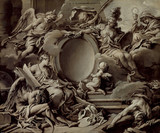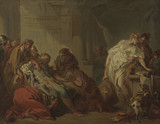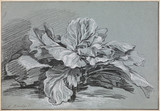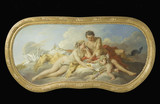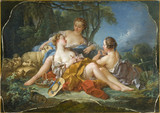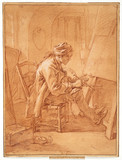A prolific draftsman and painter whose work was popularized in prints, tapestries, and porcelain, François Boucher was one of the most influential artists of the eighteenth century. His playful, colorful pastorals and genre scenes of Parisian society, and his painterly technique, helped to define the Rococo style. Boucher probably received his first lessons in art from his father, a minor painter and designer of embroidery patterns. In 1720 his painting The Judgement of Susannah (private collection) attracted the attention of the painter François Lemoyne (1688-1737), one of the major French artists of the early eighteenth century, who extended to the young artist his personal protection. Boucher won the Prix de Rome in 1723 but did not receive official funding to pay for his studies.
Remaining in Paris, he worked for the engraver and publisher Jean-François Cars (1661-1730), supplying him with drawn reductions of his paintings and designs for thesis plates, including Project for a Cartouche: An Allegory of Minerva, Fame, History and Faith Overcoming Ignorance and Time (LACMA). Boucher also made etchings after the drawings of Antoine Watteau (1684-1721) for Watteau’s patron Jean de Jullienne (1686-1766). In 1728 Boucher traveled to Rome in the company of the artists Carle and Louis-Michel Vanloo. He was particularly attracted to the masters of the Baroque—especially Giovanni Benedetto Castiglione (1609-1664), whose subject matter and bravura technique he emulated—and to eighteenth-century Venetian painting. Boucher returned to Paris around 1731. He was agréé (accepted) in 1731 and reçu (received) as a history painter by the Académie Royale in 1734 with the presentation of his painting Rinaldo and Armida (Paris, Musée du Louvre). The following year Boucher received his first royal commission. In 1736 he was commissioned to paint The Leopard Hunt (Amiens, Musée de Picardie), one of a series of exotic hunts for Louis XV’s petits appartements, Château de Versailles [see de Troy, The Lion Hunt]. A commission for The Crocodile Hunt (Amiens, Musée de Picardie) followed in 1738. Boucher was appointed professor of the academy in 1737, and director and Peintre du Roi in 1765. In addition to the king, Madame de Pompadour, the king’s mistress, and other members of the court and French society patronized his work, which ranged from large-scale mythological paintings to cabinet paintings. His cabinet pictures depicting mythology and putti, as well as landscapes, pastorals, and scenes of elegant and low-life subjects in contemporary domestic interiors, held particular appeal for private collectors. In 1736 Boucher also began to paint tapestry designs for the Beauvais factory. Following the death of Jean-Baptiste Oudry, Boucher was appointed Inspecteur sur les Ouvrages at the Gobelins tapestry manufactory in 1755. In his final years, Boucher’s lighthearted, painterly compositions were harshly criticized as frivolous by Diderot and others, who objected to the paintings’ lack of morally uplifting content expressed in restrained compositions. Nevertheless, the artist continued to receive commissions until his death.
